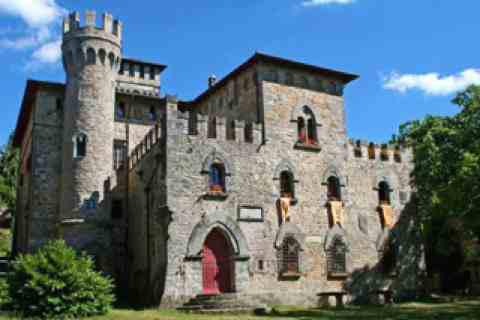After exploring the regions of Italy during the holiday season, we now resume our series on the provinces of Italy, this week visiting Bologna. The province is beautiful and varied with a landscape that spreads over the plain of Po River Valley, along the Reno and the Panaro Rivers and rises through hills and valleys to the Bolognese Apennines. And while the province offers magnificent scenery, it is better known for its outstanding art, culture and cuisine. Originally an Etruscan settlement, Bologna became a colony of the Roman Empire and later one of its cities, but it was during the Middle Ages when things really began moving. Inside the walls of the city of Bologna, the first university in the world was established in the 11th century. When it began 930 years ago, the campus had no fixed location. Lectures were held in the great halls of convents until the Archiginnasio Palace was erected. Today, the student population of this world-renowned institution totals more than 100,000. In addition to a city teeming with students, a characteristic of the province capital is its porticoes – 23 miles of them, rendering Bologna the city with the most arcades in the world.
Another of Bologna’s defining traits are its towers. In the Middle Ages, as many as 180 stood within the city walls. They were built both as a display of wealth and power, as well as for defensive purposes at a time when the city was divided between those who supported the Pope and those who were in favor of the Holy Roman Emperor. During the 13th century, many towers were dismantled or demolished and many have subsequently been used as jails and residential buildings. Today, 21 still remain, including the Azzoguidi and Prendiparte Towers, each 200 feet tall and the Scappi and Uguzzoni Towers, with each more than 100 feet tall. But the two most famous towers are the Asinelli Tower at 318 feet tall and the Garisenda Tower, 157 feet tall. The two towers are among Bologna’s most famous landmarks. Each takes its name from the families that ordered their construction in the 12th century.
Shortly after its construction, the Garisenda Tower began leaning. Today it has a greater lean than the Tower of Pisa, although it is no longer taller than Italy’s most famous tower. By the 14th century, the slant was so pronounced that its height was reduced by 40 feet. Also located in the Piazza di Porta Ravegnana, the Asinelli Tower is the city’s tallest and it too leans off center, but far less so than nearby Garisenda. It is open to the public, but to reach the top, you will need to climb 498 steps on steep wooden staircases. If you make the climb, you will be rewarded with stunning views of Bologna in every direction – with its famous red roofs, multiple towers and campanile, in addition to green rolling hills to the south.
A tour of the Emilian capital should begin in Piazza Maggiore, which has been the center of Bologna’s political and social life since the 13th century. It is one of the largest and oldest squares in Italy and was home to one of Europe’s most important open-air markets until the mid-1800s. It is flanked on one side by the Basilica of San Petronio, the 10th largest church in the world. The first stone was laid for the Basilica in 1390 and it is still not complete, but that decision was by Papal decree.
In 1514, Arduino degli Arriguzzi proposed a revised plan for the Basilica that would have made it the greatest church of the Western Christian world, even more so than the original Saint Peter’s Basilica at the Vatican. Pope Pius IV halted the majestic project and even today, the facing of the main facade remains unfinished. Curiously, entrance to the Basilica is free, but there is €2 charge if you want to take pictures. Also in Piazza Maggiore are the numerous notable palazzo’s.
Above the entrance gate to Palazzo D’Accursio is the statue of Bologna native Pope Gregory XIII, blessing passers-by. The building had three courtyards: one was for receiving guests, one for storing weapons and a third serving as the prison. The old Cardinal apartments, the City Council Room, the Morandi Museum and the Farnese Chapel are located on the upper floors and are accessed by a monumental staircase designed by Bramante. Walk through the courtyard of Palazzo D’Accursio and up the two staircases to reach the Sala Farnese for a great view of Piazza Maggiore from its windows. Nearby, is the Palazzo Del Podestà. Construction began in 1200 and it was the first seat of the local government. It was from the Palazzo’s balcony that death sentences were announced, to be carried out in the Piazza itself.
In Piazza del Nettuno, you will find the Fountain of Neptune and its bronze statue of the god, by Giambologna. Neptune holds in his hand a trident – the symbol not only of Bologna, but of the brothers Maserati, who made the city their home. Not far away is Piazza Cavour, with its porticoes and a gallery of beautifully-colored frescoes.
The charm of Bologna extends beyond the city walls. The Bagnarola Villas, known as “the Versailles of Bologna,” were built between the 16th and 18th centuries as the country residences of Bologna’s elite. Even today, the timeless beauty of the structures and their settings make this a popular stop for tourists.
About ten miles southwest of Bologna lies Sasso Marconi, a town that dates back to Etruscan times. Although few of the ancient people’s tombs still remain, the presence of the later Romans can felt or at least tasted. Its 2,000 year old tunnel/aqueduct is still in use and provides water to 20% of Bologna’s residents. The town is also where Guglielmo Marconi spent much of his youth. At Villa Griffone, the renowned inventor carried out his first successful experiments with the wireless telegraph. Now a museum, the villa features rooms each dedicated to landmarks in the history of electricity.
Further to the east is Budrio, an ancient city that still exhibits signs from the Roman and Medieval periods. It is also well-known for the musical instrument invented by Giuseppe Donati, the ocarina, which means “little goose.” The terracotta instrument is played similarly to a flute.
For those who seek the great outdoors, Corno alle Scale in the Apennines has a peak rising to 6,562 feet and offers excellent skiing and snowboarding, while nearby Porretta Terme has been known since Roman times for its thermal springs. It now boasts modern health resorts for relaxing vacations. There are also a great number of sites for naturalist, such as the Park of Bolognese Gypsum and Badlands of Abbadessa, as well as the Park of the Suviana and Brasimone Lakes.
The province of Bologna is also the perfect place to visit for those who love fast automobiles. In addition to being the home of Maserati, it also contains the famous Imola race circuit, located 25 miles east of Bologna. Its official name is the Autodromo Internazionale Enzo e Dino Ferrari, which holds an auto show annually, in addition to important car and motorcycle races.





